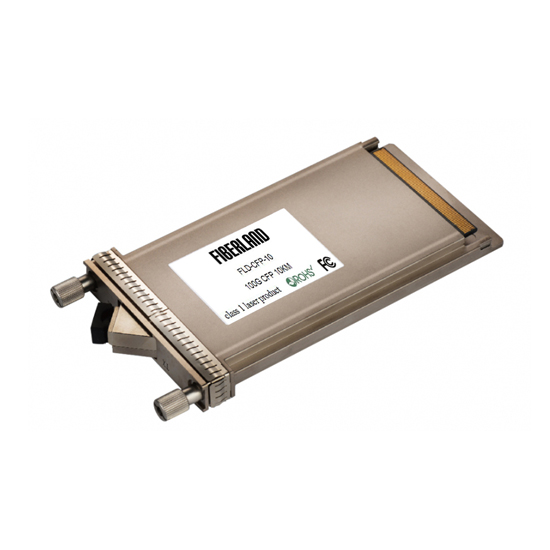The problems we met when using XFP transceiver
2017-08-31
We will meet some problems when using XFP transceiver, today we will make a summary of the problems.
1. Compatibility(The most basic and the most common situation)
Possible cause: a. Error occurred during import of compatible code
b. The device's software update cause the failure of the original non upgrade compatible code
c. Coding error
2. Product loss
Possible cause: a. The electronic function circuit of optical module and device does not match
b. Main chip and device does not match
c. Physical line fault
d. Equipment failure
e. Routing information error

3. Optical interface pollution and damage
The loss of optical link becomes larger due to the pollution and damage of optical interface, cause optical link failure.
Possible cause:
a. The optical interface exposed in the air, dust into and pollution;
b. The fiber connector end face has been contaminated, the optical interface was secondary pollution;
c. The improper use of Optical Fiber Pigtail end, end scratch etc.;
d. Use poor quality Fiber optic connectors.
4. ESD damage
ESD means ElectroStatic Discharge. Static electricity will absorb dust, changing impedance between lines, affect the function and life of the product.
Factors that cause ESD damage:
a. Dry environment, easy to produce ESD;
b. Abnormal operation, such as Non hot plug optical module live operation; Do not do electrostatic protection and touch optical module with hand directly; without anti-static packaging during transportation and storage;
c. The equipment is not grounded.
XFP module,XFP transceiver,bidi sfp,SFP+ module,SFP+ transceiver Which is good? First choice Fiberland!Thanks for your concern, to learn more about Fiberland, please enter Fiberland website: http://www.fiberlandtec.com/
1. Compatibility(The most basic and the most common situation)
Possible cause: a. Error occurred during import of compatible code
b. The device's software update cause the failure of the original non upgrade compatible code
c. Coding error
2. Product loss
Possible cause: a. The electronic function circuit of optical module and device does not match
b. Main chip and device does not match
c. Physical line fault
d. Equipment failure
e. Routing information error

3. Optical interface pollution and damage
The loss of optical link becomes larger due to the pollution and damage of optical interface, cause optical link failure.
Possible cause:
a. The optical interface exposed in the air, dust into and pollution;
b. The fiber connector end face has been contaminated, the optical interface was secondary pollution;
c. The improper use of Optical Fiber Pigtail end, end scratch etc.;
d. Use poor quality Fiber optic connectors.
4. ESD damage
ESD means ElectroStatic Discharge. Static electricity will absorb dust, changing impedance between lines, affect the function and life of the product.
Factors that cause ESD damage:
a. Dry environment, easy to produce ESD;
b. Abnormal operation, such as Non hot plug optical module live operation; Do not do electrostatic protection and touch optical module with hand directly; without anti-static packaging during transportation and storage;
c. The equipment is not grounded.
XFP module,XFP transceiver,bidi sfp,SFP+ module,SFP+ transceiver Which is good? First choice Fiberland!Thanks for your concern, to learn more about Fiberland, please enter Fiberland website: http://www.fiberlandtec.com/
RECENT BLOG POST
-
012019-10With the continuous development of 5G communication technology, 100G modules are gradually becoming popular. We know that there are many kinds of packages for 100G optical modules. From 2000 to now, the optical module package types have been rapidly developed. Its main package types are: GBIC, SFP, XENPAK, SNAP12, X2, XFP, SFP+, QSFP/QSFP+, CFP, CXP. In the fast-developing network era, some 100G optical modules avoid the risk of being eliminated, and upgraded and revised with the wave of the Internet, such as 100G CFP optical modules.
-
012019-101. What is the CWDM SFP? The CWDM optical module is an optical module using CWDM technology to implement the connection between the existing network device and the CWDM multiplexer/demultiplexer. When used with a CWDM multiplexer/demultiplexer, CWDM optical modules can increase network capacity by transmitting multiple data channels with separate optical wavelengths (1270 nm to 1610 nm) on the same single fiber.
-
012019-10AOC is the abbreviation of Active Optical Cables, which is called Active Optical Cables in Chinese. AOC active optical is to encapsulate two optical modules and cable together. Because the medium of transmission in the middle is optical cable, AOC optical module, which contains laser devices, has a higher price for DAC. However, its optical aperture is not exposed, it has high reliability, and its working distance can be customized for a long distance of less than 100 meters.
-
012019-10Dense Wavelength Division Multiplexing (DWDM) technology is capable of transmitting data in an optical fiber using bit wavelength parallel transmission or string line transmission using the wavelength of the laser.It is widely used in different fields of communication networks, including long-distance backbone networks, metropolitan area networks (MANs), residential access networks, and local area networks (LANs).The DWDM optical module is the optical module that uses this technology, so the DWDM optical module has high bandwidth and long-distance transmission characteristics.












